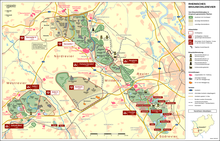Old Inden
Alt-Inden is the current name for the former capital of the municipality Inden in the North Rhine-Westphalian district of Düren . The village was relocated from May 1991 to the end of 2003 and dredged in 2005 because of the Inden opencast mine . The name lives on in the community name and in the new town center Inden / Altdorf . Around 2000 people last lived there.
history
The area of the old town of Inden was already settled in Roman times. This is evidenced by excavation finds that were uncovered on an old cemetery site during the expansion of the opencast mine (2000/04). It was found that there used to be a manor farmed between the 1st and 4th centuries, a so-called villa rustica of a wealthy Roman , on this site . It was one of Namur - Blaustein -made basin exposed, which originally served the Roman domination of the goods as a trough of a bath, and later, Frankish time as a sarcophagus the ashes and grave goods of the dead from cremations recorded. The former basin, closed for this purpose with a granite slab adapted to the shape , was broken into early by grave robbers but not completely plundered. The pool is now in Zülpich , in the museum of bathing culture there .
Inden was traversed by the Inde in a south-north direction , over which three bridges lead within the village. The Driesch on the Inde acted as a green lung with numerous chestnut trees and hawthorn trees. The B 56 ran through the town in an east-west direction, and there was a train station on the railway line from Stolberg to Jülich . Inden had a kindergarten and a primary school. There was a Catholic and a Protestant church. In 1899 the Indener Schützenbruderschaft St. Sebastianus donated the church clock for the new parish church of St. Clemens.
An important branch of industry, as in the rest of the Düren district, was the paper industry, namely the Henkel Düsseldorf paper factory. There was also the Meuther u. Co. (formerly Heymann), the van Riel rag sorting facility, a leather factory, the Johnen distillery, the Carrier family's Büsgesfabrik and the Delahay mill.
In the 1920s and 1930s, Inden was one of the most beautiful villages in the Jülich district .
From 1927 Inden was the end point of the meter-gauge railway line from Düren and Birkesdorf on the Düren Railway . Rail traffic was finally stopped on June 30, 1965 and replaced by a bus line.
With the dissolution of the Jülich district, Alt-Inden came to the Düren district on January 1, 1972. At the same time, the former places Altdorf, Frenz, Lamersdorf, Lucherberg, Pier and Schophoven were included in their own municipality.
Individual evidence
- ↑ Information from the Museum of Bathing Culture, Zülpich
- ^ Federal Statistical Office (ed.): Historical municipality directory for the Federal Republic of Germany. Name, border and key number changes in municipalities, counties and administrative districts from May 27, 1970 to December 31, 1982 . W. Kohlhammer, Stuttgart / Mainz 1983, ISBN 3-17-003263-1 , p. 306 .
Web links
- Earth clod archive with map of Inden and Altdorf
- Homeland and history association
Coordinates: 50 ° 51 '41.3 " N , 6 ° 21' 27.8" E


